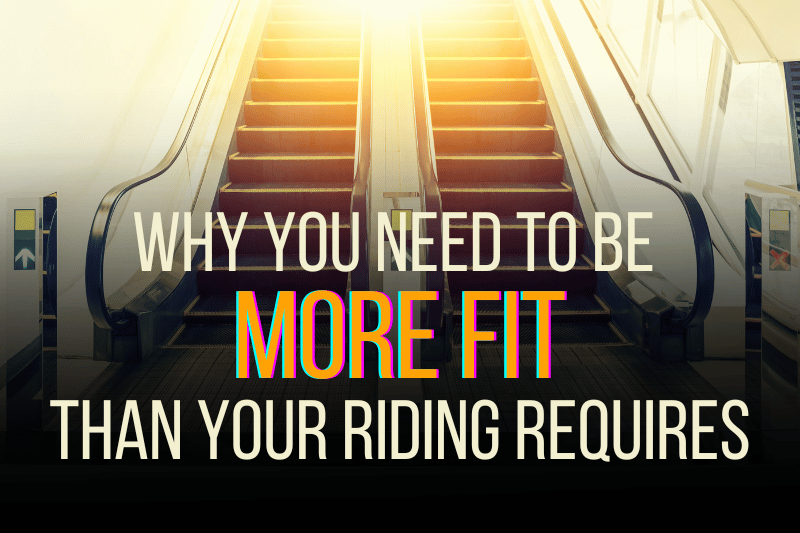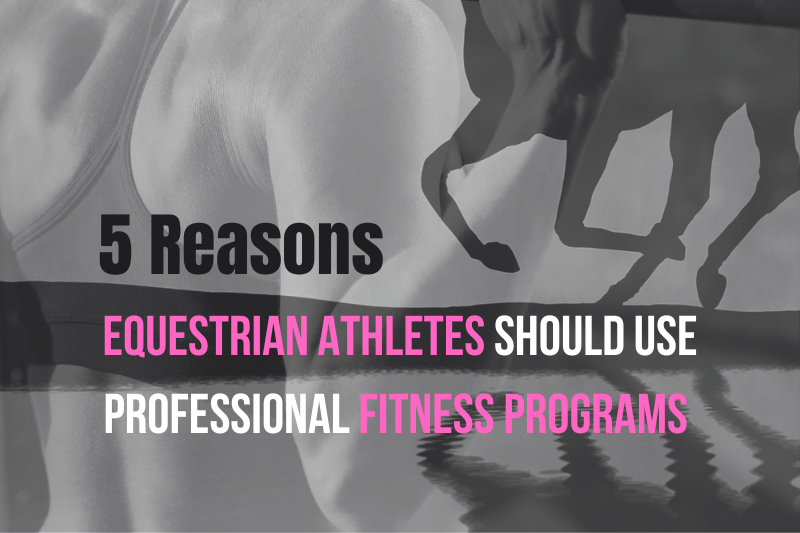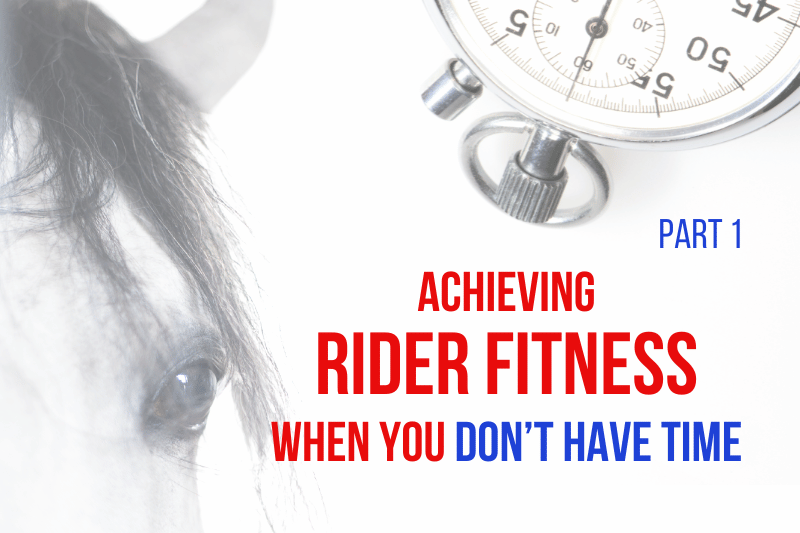Let’s face it: You don’t have to be spectacularly fit in order to ride a horse.
Of course it takes effort. Of course it takes more strengh to ride well than to be a sack-of-potatoes passenger. But the fact remains that you don’t need to be able to sprint up a hill, run a 10K, deadlift twice your bodyweight, or do pullups in order to complete a dressage lesson or 50-mile endurance ride.
So, why bother?
Here is the reason equestrians need to have more strength, power, symmetry, cardiovascular fitness, and mobility than riding requires:
The Escalator is Going Down
Let’s play a little game.
Imagine you’re at the halfway point on an escalator that is going down. If you reach the bottom of the escalator, you lose.
In order to keep from losing, you have to climb up the escalator, against its downward pull. If you climb at the same rate the escalator descends, you’ll never lose, right?
Not so fast.
Unluckily for you, this escalator has a nasty trick. It keeps speeding up. You might be able to climb faster and hold your ground for a while, but eventually you’re going to find yourself descending no matter how hard you try.
Inevitably, you’re going to lose. Sorry about that.
The best you can do is to extend your game. How? Ideally, by:
- Beginning to climb early, before the escalator gains speed,
- Climbing faster than the escalator descends, and
- Climbing consistently for the duration of the game.
Conversely, the worst thing you can do is stand still and let the escalator carry you down. You might be comfortable in the short term, but the game will end in short order.
The game, of course, is your healthspan. You want it to last as long as possible. The escalator is age-related decline, and it speeds up as you get older. The floor below is the point at which physical limitations render you unable to ride.
You extend can your healthspan (including your ability to ride) by intentionally working on physical fitness. The sooner, harder, and more consistently you work, the longer you’ll last before hitting the floor.
This isn’t a perfect analogy. Healthspan is impacted by factors beyond our control, like accidents and genetics. However, it only makes sense to focus on what we can control. Achieving a high level of fitness ~ much more than riding requires today ~ will give you a lot of escalator to go down before you hang up your bridle for good.
Use It or Lose It
Born to Run author Christopher McDougall famously said, “You don’t stop running because you get old. You get old because you stop running.”
It’s not just running. How about sitting on the floor, climbing stairs, leaping over a creek, reaching overhead, balancing on one foot, climbing a ladder, mounting a horse? There are myriad human movements that most elderly folks used to do without thinking, but now wouldn’t even consider. They didn’t just decide one day to quit, did they?
Of course not. Some got injured and never resumed their prior activities. Most, however, simply took the easy path. They moved to a single-level home, rode the elevator at work, strolled on the greenbelt instead of hiking in the foothills.
They didn’t bother to jump or sprint…and then they didn’t want to jump or sprint….and eventually they couldn’t jump or sprint.
Did you catch that middle phase? The bit about not wanting to? Perhaps lack of willingness to participate in challenging movement is, itself, an early indicator of decline.
Oof. Wake-up call.
If you want to play the game for a long time, you can’t stand still on the escalator. You have to choose to fight back.
The Sooner the Better, but Better Late than Never
If you’re young, or even young-ish, you are blessed with the opportunity to maximize your healthspan and lifespan. However, plenty of studies have shown that even very frail, elderly folks can regain strength and mobility with appropriate training.
Most of us are somewhere in-between, and all of us are still in the game. We can’t go back and start climbing the escalator earlier, but we can surely set our minds to climbing it faster.
Did your mind immediately go to “I can’t because…”?
Take a moment to question that. Really challenge it.
If time is the issue, check out Rider Fitness When You Don’t Have Time, Part 1 and Part 2.
If money is the issue, just google how to work out for free.
If physical limitations (from injury to lack of energy) are the issue, consider working with a professional. It’s amazing what great physical therapists, medical practitioners, hormone specialists, and fitness experts can do.
This is too important to resist. Too important to give up on. Too important to ignore.
Fitness is a gift to your future self. Give it all you’ve got.
You might also like
This page may include affiliate links, and I may earn a small commission (at no extra cost to you) when you purchase through these links. I only recommend products and services I think are helpful and useful. Thanks for helping me offset the cost of maintaining this blog as a free resource!





I just discovered your blog, thanks to a referral from the wonderful Dessia Miller. I look forward to reading you!
What a pleasure to have you reading! Thanks so much for writing to say hello. And, shout-out to Dessia! 🙂
I love how you have explained this concept. I am 63 and have worked to stay fit and am pretty fit. I have always loved being fit enough to enjoy doing all the things I like to do, such as, ride horses, ski, swim, lift weights, ride my mountain bike etc. Life is full of fun activities, but if you aren’t fit enough, you can’t enjoy them. I think many people thing about exercising and say, “I have to…” I say, “I get to…” Mind set is everything.
Yes! That is so true, and absolutely top of mind for me this morning as I ponder the unlikely turn of events that swung me from an anticipated lackluster competition year to a Tevis year. Being fit was a baseline criteria for being prepared to ride Atlas. It opens doors.